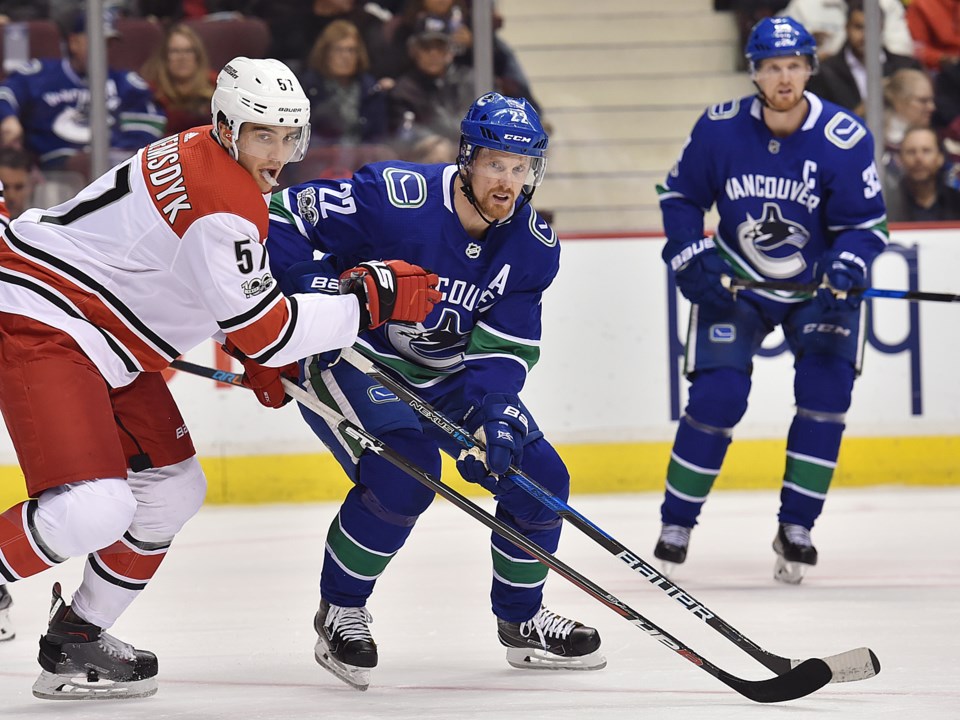The Paper Feature is a weekly column and sidebars that appears in the print edition of the Vancouver Courier newspaper. Track it down!
The last time the Canucks had a massive amount of cap space heading into the off-season, Jim Benning spent it all on two big-name, veteran free agents. It was Benning’s first summer as general manager of the Canucks and a number of big contracts were off the books: Roberto Luongo’s $5.3 million, David Booth’s $4.25 million, and Ryan Kesler’s $5 million.
That left plenty of room for Benning to sign Ryan Miller and Radim Vrbata to $6 million and $5 million cap hits. The signings fit Benning’s stated intentions of turning the Canucks around quickly. This time around, however, Benning should avoid the temptation of free agency.
Daniel and Henrik Sedin’s retirement took $14 million off the Canucks’ cap hit, almost all of which will be available for the Canucks to spend. The issue is that the Canucks are not in a position to benefit from the addition of one or two veterans. Nor are many free agents likely to see the basement-dwelling Canucks as a premiere destination, so the Canucks would potentially have to open up their wallets to an uncomfortable degree.
It’s difficult to tell what Benning is planning to do with all that cap space, but Benning gave some hints at his plans in an interview with NHL.com.
When asked whether the Canucks will make a big splash in free agency to replace the Sedins, Benning said that they will instead look to their young players to grow into that larger role. After saying that, however, he suggested they won’t be completely quiet.
“Let's face it, it's hard for 20, 21, 22-year-olds to lead an NHL team,” he said. “Look at the playoffs. It's that age group, from 26-32, that you win with.”
When you look at the Stanley Cup Champion Washington Capitals, they certainly fit that description. While some key players — Andre Burakovsky, Tom Wilson, Jakub Vrana, and Christian Djoos — are younger than 26, the core of the team is in that 26-32 age range. You can also look at the 2011 Canucks: Ryan Kesler turned 26 heading into the 2010-11 season, while the Sedins had just turned 30.
The truth is that nearly half the NHL is 26-32, so any given team is bound to have a large chunk of their players fall within that range. It’s also not difficult to find counterexamples: the Pittsburgh Penguins won their last two Stanley Cups with a core between 26 and 32, but they won back in 2009 when their core of Sidney Crosby, Evgeni Malkin, Kris Letang, Jordan Staal, and Marc-Andre Fleury were all in their early twenties.
Let’s say, however, that most teams that win the Stanley Cup have a core group that is aged 26 to 32. Assuming that to be true, what should a team do with that knowledge?
Does this mean that a team should go out and sign free agents within that age range in order to compete for a Cup? John Tavares is 27 and John Carlson is 28. If the Canucks shed some salary in trades, they could throw money at both of those players, giving them a first-line centre and a top-pairing defenceman. Would that fix the Canucks’ myriad problems?
No. The Canucks simply aren’t in a place where one or even two high-priced free agents would put them over the top.
What that 26-32 age range suggests instead is that a rebuilding team needs to put together a generation of players aged 18-24 that, in six years time, will be the core of a Cup-contending team. Adding older players in free agency can make a team less bad, but is no substitute for building a core from within.
The Canucks have some key pieces in that age range right now. Bo Horvat is 23, Brock Boeser is 21, and Nikolay Goldobin is 22, and they’ll potentially be joined by rookies Elias Pettersson, Adam Gaudette, and Jonathan Dahlen next season.
Where the Canucks lack future core players in that age range is on defence. Troy Stecher is 24 and the Canucks have high hopes for Olli Juolevi, who just turned 20, but have little else on the blue line, making it essential that they add defencemen in the upcoming draft.
If Benning is right about Cup contending teams needing their core to be aged 26-32, Canucks fans could be in for a long wait as their young players grow and mature. If Benning doesn’t address the need for young defencemen in the system, however, that wait could be even longer.
Stick-taps and Glove-drops
A tap of the stick to Alex Ovechkin and the Washington Capitals for finally breaking through and winning their first Stanley Cup in franchise history.
I’m dropping the gloves with those few members of the hockey media who chastised Ovechkin for how he celebrated the first Cup win of his career. Ovechkin’s revelries haven’t hurt anyone and he’s well within his rights to have some catharsis after years of playoff disappointments.
Big Numbers
1991 - The Washington Capitals became the first team since the 1991 Pittsburgh Penguins to win the Stanley Cup after trailing in all four playoff series. After losing the first game of the Finals to the Vegas Golden Knights, the Capitals rattled off four straight wins to take the series.
7 - Alex Ovechkin is only the seventh player in NHL history to lead both the regular season and playoffs in goalscoring, and the first since 1981, when Mike Bossy managed that feat. His 15 playoff goals also broke a Capitals franchise record.



